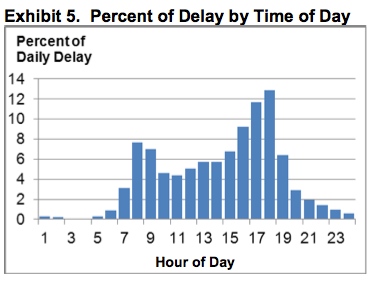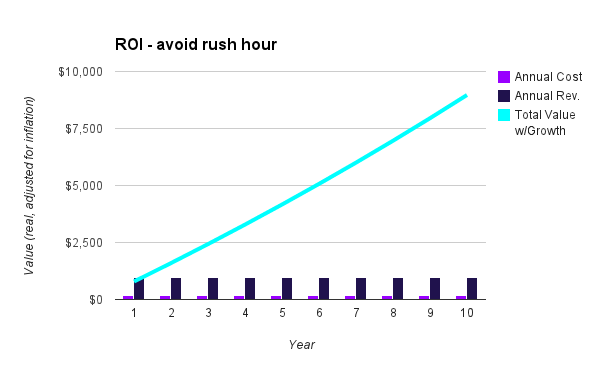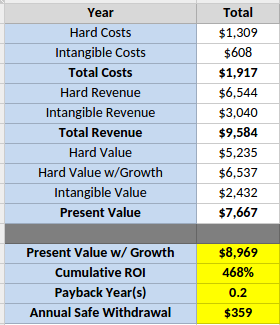Abstract
Shifting one’s work commute to earlier or later in the day to avoid rush hour traffic could theoretically save the average American about $900 per year.
Intro
I’ve written in the past about the outstanding financial benefits of working from home, living closer to work, and riding a bike to work. But what if those aren’t feasible options? Well, there are still other ways to save money on your daily commute.

I’m talking about avoiding the worst hour or two of the day… rush hour. There is almost no other regular annoyance worse than rush hour traffic. The average American spends almost a full work week (38 hours) stuck in traffic each year, which ends up costing them over $800 in extra gas money per year as well. And the problem is even worse in big cities.
A Better Way
So what if there was a way to reduce all this wasted time, wasted money, and daily frustration? Enter the staggered commute.
This chart from The Atlantic’s “The American Commuter Spends 38 Hours a Year in Traffic” shows the best and worst times of the day to commute:

What this shows is that 8-10 AM and 4-6 PM are the worst times to commute. This is no surprise as most Americans work some variation of the 9 to 5 job. So the rational thing to do, if possible, is to stagger the commute (and workday) by a couple of hours. Instead of leaving for work at 8 and coming home at 5, a morning person could leave at 6 and come back around 3. Or a night person could leave for work at 10 and come back at 7 (not as optimal, but still saves time).
Running the Numbers
In this example, I’m going to assume that a car commuter can reduce their time spent in traffic by 80% with a staggering commute. I’m also assuming that commuting to work accounts for some 30 of the total 38 hours that the average American spends in traffic each year. And per my normal assumptions, I’m using my personal time value estimate of $10 per hour and also assuming the cash savings of using less gas will be invested in the stock market and earn a 4% real rate of return.
So what much does one stand to save by shifting their commute to less trafficky times of the day?
- 10-Year NPV: $8,969
- 10-Year ROI: 468%
- 10-Year Payback: 0.2 years

So switching one’s commute to a less busy time of the day saves almost $9,000 over 10 years, or about $900 per year on average.
For some people, the thought of having to battle the snooze button on a buzzing alarm clock two hours earlier each day might not be worth $900 per year because, let’s face it, sleep is important. But if compensated for by going to bed a little earlier, a staggering commute could actually make a lot of sense.
Waze: A Third-best and Supplemental Traffic-saving Option
Most readers probably already know about the free GPS app Waze, but I’d be remiss not to mention it in this post. Even if someone cannot shift their schedule around to avoid rush hour traffic, there are still savings to be had by using an app like Waze. Additionally, Waze can help everyone save time with one-off traffic jams on weekends and holidays.
The app was purchased by Google last year and has very accurate real-time traffic data. It uses this data to dynamically adjust routes to get people to their destination in the quickest way possible. Waze regularly saves me 5-10 minutes on my weekday commutes (when I don’t ride my bike) and often helps me find country road shortcuts on road trip traffic jams.
It is an easy way to save money, so check it out!
Conclusion
Traffic is a pain in the rear, but it also costs the average American quite a bit of money on an annual basis. There are ways to reduce this expense if one is diligent and motivated. Cycling, working from home, and/or living closer to work are the best bets, but shifting work schedules to less busy times of the day also represents a sizable opportunity.
